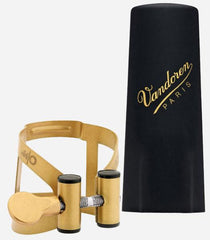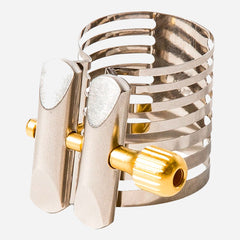Does it Make a Difference? Part 3: Ligatures
Throughout our time here at Sax.co.uk, we get asked many different questions about many different products. One of the most common questions we get is “does it really make a difference?”. This can be a hard question to answer sometimes without in depth analysis, so I figured I’d channel my inner Louis Theroux and investigate! So here we go with Part 3: Ligature. Prepare yourselves gang, we are going down the rabbit hole here.
Hold on, surely we should be talking about Mouthpieces here?
It is very well documented how much difference a mouthpiece can make to your sound (we have in fact covered this topic multiple times on this blog, both as a comparison between metal and ebonite mouthpieces and a guide to choosing your first jazz mouthpiece. What does go under the radar is how the ligature, the device that is used to hold the reed on the mouthpiece, affects the tonal response overall. There are many pros out there who will swear either way that the ligature makes a huge difference, and some that will say that the tonal response is all on you.
What am I looking out for with a new ligature?
When shopping for a new ligature, you have to take the exact same principles as you would searching for a new saxophone or mouthpiece. The key factor we have to consider with a ligature is the resonance of the reed. Certain ligatures will try to control the amount of resonance a reed will have, and some will let the reed fly. This resonance and resistance will be the most obvious difference for a player when testing a new ligature. The security of the reed onto the mouthpiece is another consideration. A ligature that doesn’t feel comfortable to set up and use will not only compromise the playing performance, but will cause a level of playing anxiety that is just unnecessary. If the ligature isn’t well made and easy to use, there is just no point in using it. I do feel, personally, that aesthetic does have something to do with performance as well. A piece of kit that looks and feels lush to use will improve your playing (this could very well be a placebo/hooey consideration, but playing an instrument is all about having both the physical and mental edge, and if you think you look awesome you will play awesome!)
Can ligatures really vary in style?
In recent years, the amount of ligatures out on the market has absolutely exploded. The market has truly expanded from the basic brass ligature. You can now get ligatures made from leather, canvas, a menagerie of plated brasses and chord, all of which will have different contact points on the mouthpiece, giving the reed a varied resonance response corresponding in different tonal responses. The summary is, yes they can vary massively, with variations within variations in each category.
The general rule is that a leather or canvas will let the reed resonate slightly less, whereas a metal ligature will resonate more. Silver Plate will give the reed a little more resonance whilst Gold Plate will give the player more resistance. For this reason I am not going to dive into the minutiae of each variation of ligature model (as that would make what is already a dense subject, even more dense, and even a giant nerd like myself might find that dryer than my failed attempts at cooking a Victoria Sponge) and instead focus on the main models: Basic, Rovner Dark, Vandoren M|O, Rovner Platinum, Vandoren Optimum, Francois Louis Ultimate, BG Duo and Silverstein Works.
BASIC BRASS LIGATURE
Fits: Everything (though anything other than Hard Rubber Alto and Tenor is difficult to get hold of) Buy Basic Ligature
Buy Basic Ligature
This is going to be a ligature we have all come across at some point in our
saxophone playing life. This ligature can also be referred to as a “stock” ligature, as it is the ligature commonly packaged with new mouthpieces. They are made of brass and typically have two screws that are set to the bottom right when affixed to the mouthpiece. They are very much the sum of their parts: cheap.
They are clumsy to use and apply to the mouthpiece and typically warp when trying to manipulate the mouthpiece on and off of the horn. Tonally they are relatively stable. Their metal construction means that there is a fair amount of resonance from the reed leading to a responsive sound, but the poor quality of the ligature itself makes the Basic Brass Ligature feel cheap to use, uncomfortable to set up and ultimately something you can’t 100% rely on to work.
ROVNER DARK
Fits: Everything Buy Rovner Ligature
Buy Rovner Ligature
This is a favourite amongst professionals and students alike. Rovner make many, many different variations on this style of ligature but the Rovner Dark has been the most popular version, with artists like Bob Reynolds famously sticking with this ligature. The Rovner Dark is made from a faux leather, rather than brass. What this does is makes the ligature naturally flexible, ensuring a tighter fit around more unique mouthpiece shapes as well as being easy to apply to the mouthpiece itself. It does the job and does the job well.
Where this ligature struggles against metal styles is in the tonal response. The material finish absorbs the vibrations from the reed, giving the tone a somewhat muted, darker edge. Some players can find this a bit restrictive (unless you’re a Bob Reynolds type who can make anything sound great and give me a huge musical and emotional existential crisis) especially in the altissimo register. However the convenience of the ligature, as well as the price point, make it certainly worth considering, especially for metal mouthpiece fans, as the Rovner Dark comes in a huge variety of sizes and the darkness can offset some of the brighter edge from metal pieces.
VANDOREN M|O
Fits: Hard Rubber Sop, Alto, Tenor and Bari Buy Vandoren M|O
Buy Vandoren M|O
The first of the Vandoren brass pieces is a rather pretty, minimalist piece of kit. The first comparison you can feel between this and the basic brass ligature is in the quality of the build. At no point do you feel this ligature will bend or break from simple application, even though the ligature is lightweight and minimal in design. The idea here is to brace the reed with two slim bars, rather holding the whole reed such as with a material Rovner.
What this does is lets the reed resonate a little more freely, as there is less contact onto the reed. What this gives you is more reed response to play with, allowing for more flexibility when manipulating the sound. Upon trying the ligature, I did find the sound The issue with the M|O is with the fit itself. Though it is a very slight and well made ligature, it can sometimes slip when applying to the mouthpiece. This ligature also suffers from the same issue we are going to find with most of the metal ligatures in that they are not flexible to different profiles of mouthpiece. The M|O is fine if you are using a standard hard rubber mouthpiece, but if you are using a metal ‘piece or have a slim line hard rubber ‘piece, like a Berg Larsson, this ligature simply won’t fit.
ROVNER PLATINUM
Fits: Hard Rubber Alto and Tenor Buy Rovner Platinum
Buy Rovner Platinum
Much like the standard Rovner style ligatures, the Rovner Platinum is a very comfortable and easy ligature to fit and use. The Platinum is also one of the very few examples of a ligature that can be applied either with the screw in the bottom right, or with the screw in the top right as it is with standard Rovner products. The first feeling you get with this ligature is a distinct core to the sound. The way the ligature lets the reed resonate allows for a nice mix of zip and centre. The Platinum is a very solid piece, feeling a lot more substantial compared to the M|O. The Platinum feel very much like a hybrid model between fabric and metal ligatures. This leads to my biggest issue with this ligature.
The Platinum is a jack of all trades, therefore er is a master of none. It doesn’t quite have the free-blowing reed responsiveness you would expect from most metal ligatures and doesn’t quite have the centred core of a fabric ligature. The tonal response is even and true, and would be perfect for anyone looking for a solid, well made ligature that will last. If you are looking for something with more, there are other options out there that will do more.
VANDOREN OPTIMUM
Fits: Hard Rubber Sop, Alto, Tenor and Bari, Metal Tenor Buy Vandoren Optimum
Buy Vandoren Optimum
With the introduction of the Vandoren Optimum, we are now diving into the upper end of the upgrade ligature market. The Optimum is not only made very well, but has many clever extras and mechanical differences that gives it an edge over other ligatures on the market. For example, the design of the tightening screw is much like the Rovner Platinum, but the unique double-track screwing mechanism means that the pressure onto the reed and mouthpiece will be evenly distributed, allowing for a more consistent tonal response.
The design is substantial, making it easy to fit onto your mouthpiece and adjust your set-up on the fly. Even small details like the base plate being interchangeable, allowing for a more personalised tone and reed response (though these changes, to my ears, are very minimal) sets the Vandoren Optimum up as a very capable piece of kit. I must say it isn’t the best looking ligature on the market but aesthetic shouldn’t really come into this decision (although let’s be real, looking cool is very important…)
FRANCOIS LOUIS ULTIMATE
Fits: Everything Buy Francois Louis Ultimate
Buy Francois Louis Ultimate
Speaking of aesthetically pleasing ligatures, there isn’t a ligature on the market that is as cool looking as the Francois Louis Ultimate. With its minimal art deco design, it makes for an incredibly striking visual display, and somehow makes you look like you really know your stuff! Performance wise, there is a good reason why it is one of our most popular options in store. The base plate of the ligature is distinctively scooped, meaning that there are less points of contact onto the reed. This allows the reed to resonate very freely and gives the player complete freedom with harmonic response, whether you want to throw your weight behind the sound and get a very loud and bright sound, or sit on it slightly and let the earthiness and core of the reed shine through.
The Ultimate comes in a variety of different sizes to suit pretty much any mouthpiece type and size, giving players an option other than a standard Rovner for some of those smaller pieces. The one drawback I have found is that the Ultimate can be a bit fiddly to set up. The metal rods that form the body of the ligature has to sit flush against the mouthpiece, which can be both a pain to set and could potentially scratch your mouthpiece if you’re not careful.
BG DUO
Fits: Alto and Tenor Hard Rubber (other sizes are available via special order) Buy BG Duo Ligature
Buy BG Duo Ligature
The BG Duo is one of the newer models to us in Sax.co.uk, and oh boy BG have come out swinging with their premier model. The Duo takes all of the resonance ideas that the Francois Louis Ultimate and marries it with the ease and comfort of the Rovner models. The points of contact on the reed and the mouthpiece are very minimal, only in about 5 places. This lets the reed do its thing; resonate at an absolutely colossal rate. Upon putting this on and trying it for the first time, I was truly astounded by the shear velocity of the reed. The BG Duo really lets the reed open up on the mouthpiece, allowing for a bigger, more free-blowing response both tonally and physically. This does have the slight draw-back, in the sense that you absolutely have to have your wits about you when playing on this ligature. If you are not careful, you will find yourself pushing harder than you need to and subsequently pushing yourself out of tune, which isn’t ideal! This is a very small blemish in what is a very competent ligature.
SILVERSTEIN WORKS
Fits: Everything  Buy Silverstein Works Ligature
Buy Silverstein Works Ligature
The Silverstein Works was the final ligature I decided to look at, as it is our most premium model. The basic model will start only a little bit shy of the price of the top end BG Duo, and the most elaborate model (with literal diamonds in it) will cost you nearly £1000! It is a bloody mad amount of money, so what does it get you? Well, on first impressions, not an awful lot. Unlike the other high end ligatures on this list, the Silverstein Works are made from a patented dotted chord. The idea of this is, rather then trying to contact the reed as little as possible, the chord will spread the pressure evenly across the reed and mouthpiece, allowing for the utmost consistency across all frequencies.
Every aspect of the Silverstein ligatures, from the dotted chords to the special coated finish on the metal components through to innovative 4 fine tuners, has been meticulously researched and developed to produce the most consistent sound across the whole of the instrument. Couple this with an incredibly stylish aesthetic and what you get is a very serious piece of kit. The tonal response is very even across the whole range of the saxophone, meaning that certain registers will not pop out too much suddenly or just disappear. This is such a valuable asset, knowing that your playing will be consistent, but you have to pay a heavy price for this consistency.
VERDICT
To answer the question; does it make a difference? Yes. A decent ligature can make a sizeable difference to your sound and responsiveness from your reed and mouthpiece. When comparing between a basic brass ligature and any of the more premium products, the difference you can feel in both playability and comfortability is staggering. When comparing between the premium ligs does become more nuanced. I have found a Rovner style ligature will give you plenty of stability and are very easy to apply, but can strange some of the upper frequencies. For this reason I feel that the material ligatures like Rovners and Silversteins work very well with metal mouthpieces. The Metal ligatures are more awkward to apply and use release the upper frequencies and lets the reed resonate very freely, which works especially well with stuffier, darker mouthpieces.
I guess the overall take away from this is, what sort of response are you looking for as a player. Aurally, the differences between the ligatures are going to be very slight, but the feeling and response from the reed will vary wildly. Come down, try them all out, see what sticks. Either way upgrade from a basic brass ligature because they’re trash and you deserve better.



